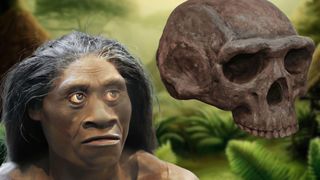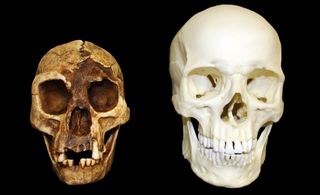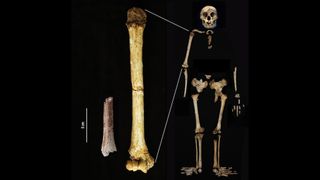Homo floresiensis: facts about the 'hobbit'
Homo floresiensis, a diminutive hominin dubbed the hobbit, lived for hundreds of thousands of years on a remote Indonesian island.

Homo floresiensis, dubbed "the hobbit," was an ancient hominin that lived until at least 17,000 years ago.
Scientists discovered the first H. floresiensis fossil, along with stone tools and animal remains, in 2003 in the Liang Bua (LB) cave on the remote Indonesian island of Flores, according to the 2004 Nature paper describing the extinct human lineage. This first specimen — a 3.5-foot-tall (1 meter), 30-year-old adult female called LB1 — comprised a nearly complete skull and an associated skeleton, which includes several limb bones, hand and foot bones and a partial pelvis, according to the study.
"Its associated skeleton is one of the things that makes this specimen quite exciting," Mark Collard, a biological anthropologist at Simon Fraser University in Burnaby, British Columbia, told Live Science "We don't have very many associated skeletons of hominins outside of Neanderthals."
LB1's tiny build earned the species the nickname of "The hobbit," after the tiny folk in J.R.R. Tolkien's book of the same name.
In addition to LB1, archaeologists later discovered jaw and skeletal remains of at least eight other diminutive individuals, according to a 2009 article in the Journal of Human Evolution. The small stature of these specimens suggests LB1 wasn't an anomaly.
Initial dating of the hobbit remains estimated that they lived between 100,000 to 60,000 years ago. However, hobbit bones and teeth found in a separate location suggest the "hobbit" lived on Flores at least by 700,000 years ago.
Just how H. floresiensis fits into the family tree of hominins — which includes those species that evolved after the human lineage (of the genus Homo) split from chimpanzees — is unclear. Some recent arguments suggest the hobbit specimens may have evolved from a pre-Homo. erectus hominin.
In fact, scientists have sought to learn more about the evolution of this hobbit, looking for clues, for instance, for hobbit ancestors on other Indonesian islands. In one 2016 study in the journal Nature, a team of researchers looked for such clues on the Indonesian island of Sulawesi, situated between Flores and continental Asia. There, they found stone tools dating back at least 118,000 years, suggesting some hominin species lived on the island before modern humans showed up some 50,000 years ago, said study researcher Gerrit van den Bergh, a paleontologist and zooarchaeologist at the University of Wollongong in New South Wales, Australia. The researchers aren't sure who this toolmaker was, though three possible candidates are: the hobbits, H. erectus and the Denisovans, close relatives of Neanderthals.

What did the hobbit look like?
Based on LB1, experts estimate H. floresiensis weighed between 35 and 79 lbs. (16 and 36 kg), according to the 2004 Nature study. Newer bones and teeth unearthed in a separate location on the island of Flores suggest the creatures may have been shorter on average, standing less than 3 feet (0.9 meters) tall, however.
The hobbit specimens show a unique set of ancestral features (primitive traits retained from an ancestor species) and derived features (evolved features not shared by ancestors). Certain features resembled early Homo species, including a flat, sloping forehead and a short, flat face; however, their teeth and jaws more closely resembled Australopithecus (Homo ancestors), according to Nature.
Additionally, in a 2007 study in the journal Science, researchers closely analyzed three wrist bones of LB1 and found they more closely resembled those of apes than modern humans.
In 2012, Susan Hayes, a senior research fellow at University of Wollongong, and her colleagues fleshed out the female hobbit's face by uploading information from 3D imaging scans of its skull into a computer graphics program. Compared with portraits of the hobbit by paleo-artists, Hayes' facial depiction of H. floresiensis showed more modern human features instead of monkey-like traits.
What did Homo floresiensis eat?
When researchers first unearthed H. floresiensis, they also uncovered stone tools and animal remains in the same sediment layers of the Liang Bua cave. The tools were simple and Oldowan-like, resembling the earliest and most primitive types of tools in the fossil record.
The animal remains included those of Komodo dragons, rats, bats and Stegodon (an extinct, pygmy elephant) juveniles. The Stegodon remains showed evidence of cut marks, suggesting H. floresiensis butchered the animals, while charred bones and fire-cracked rocks suggest the hobbits harnessed fire, according to the 2005 Nature paper.
Inside the Liang Bua cave, scientists later found several bird fossils, including wing and leg bones from what appears to have been a large stork, according to a 2010 study in the Zoological Journal of the Linnean Society.

Did humans and Homo floresiensis live together?
The hobbits likely did not coexist with modern humans, and if they did, it wasn't for long. Initial research suggested the hobbits occupied the cave between about 12,000 and 95,000 years ago, which would have meant the two human lineages coexisted, given that humans arrived in Flores around 47,000 years ago. A 2016 study in the journal Nature, however, analyzed the sediments and fossils within the Liang Bua cave and found evidence that the hobbits vanished from the island earlier, around 50,000 years ago.
Was Homo floresiensis a separate species?
The hobbit was most likely a separate species, the vast majority of research suggests. Critics have argued that H. floresiensis was not a separate species, but rather a modern human with microcephaly, a pathological condition characterized by a small head (the hobbit is estimated to have a brain about one-third the size of modern humans), short stature and intellectual disabilities.
After comparing brain dimensions deduced from internal casts of the skulls of healthy humans and those with microcephalia, to the estimated dimensions of the brain of H. floresiensis, scientists determined the hobbits features were closer to a typical modern humans' rather than those of a person with microcephaly, a 2007 study in the journal PNAS found.
A study published in 2013 in the journal Proceedings of the Royal Society B revealed H. floresiensis had a brain of about 426 cubic centimeters (nearly 26 cubic inches). That's roughly one-third the size of the modern human brain, which boasts an average volume of about 1,300 cubic cm, or 79 cubic inches.
The findings suggested H. floresiensis may descend from H. erectus, as Javanese specimens of H. erectus had brains about 860 cubic cm (52 cubic inches) in size. Alternatively, the hobbit may have evolved from H. habilis, whose brains were only about 600 cubic cm (37 cubic inches), the research suggested.
In a study published in 2015 in the Proceedings of the Royal Society B, Collard and his colleagues compiled a dataset containing 380 skull and dental features for the 20 known hominin species. After analyzing and comparing these features using statistical models, they concluded that H. floresiensis was, indeed, a distinct species and not just a small-bodied or deformed human.
What's more, the analysis suggests that the hobbit is a descendent of a pre-H. erectus small-bodied hominin that migrated out of Africa and to Southeast Asia.

Why were the hobbits so small?
In 2024, archaeologists discovered 700,000-year-old teeth and a partial upper arm bone (humerus) in Manta Menge, a separate location on Flores north of the Liang Bua cave. Analysis of the fossils revealed that H. floresiensis stood 2.4 inches (6 cm) shorter than previously thought. The humerus may be the smallest ever reported from an adult, according to a study published in the journal Nature Communications.
The researchers in that study suggest the diminutive humans may have evolved to be shorter thanks to their island environment. Islands typically lack large predators, making it less advantageous to be big. Meanwhile, growing bigger requires more food and more time to grow. So natural selection may have gradually shrunk the hobbits to adapt to their environment, the researchers suggested.
Editor's note: This article was originally published on March 30, 2016 and updated by managing editor Tia Ghose on Aug. 6, 2024 to include more recent research on the Homo floresiensis.
Additional resources
Sign up for the Live Science daily newsletter now
Get the world’s most fascinating discoveries delivered straight to your inbox.

- Tia GhoseManaging Editor